Crevalle Jack
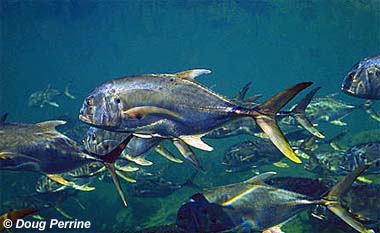
Caranx hippos
This large fish is wonderfully abundant in the Atlantic Ocean, and popular resource for both commercial and sports fishers alike. The juvenile is striped vertically along its sides, but as it matures, it changes to an even greenish-bluish above and silver or golden below. Usually adults measure around 24 inches long; it has been caught and measured almost 40 inches long.
Order: Perciformes
Family: Carangidae
Genus: Caranx
Species: hippos
Common Names
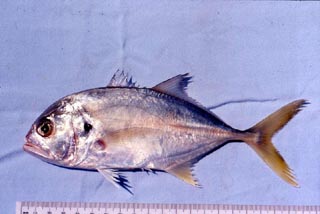
English language common names include crevalle jack, black cavalla, blacktailed trevally, caballi, cabalo, common jack, couvalli jack, crevelle jack, green jack, horse crevalle, horse mackerel, horse-eye jack, kingfish, trevally, and yellow cavalli. Other names are carngue cravalle (French), jurel comun (Spanish), bolchoi caranske (Russian), caballa (Spanish), camard (French), carango cavallo (Italian), carangue crevalle (French), carangue macoque (French), cavalla (Spanish), cavalli (French), charo-largo (Portuguese), chumbo (Spanish), coa (Portuguese), cocinero (Spanish), corcovado (Creole), couvalli (French), cowreh (Krio), crevalle toro (French), crevalle (French), enforcado (Creole), enxareu (Portuguese), enxareu-macoa (Portuguese), grande carangue (French), hevospiikkimakrilli (Finnish), hiraaji (Japanese), jejerukan (Malay), jiguagua (Spanish), jurel (Spanish), jurel caballo (Spanish), jurel cola amarilla (Spanish), jurel comun (Spanish), kanxant (Palicur), karang (French), karanks atlantycki (Polish), kawre kanki (Susu), kokalli (Greek), macoa (Portuguese), munaguroaji (Japanese), paeya (Galibi), peixe-prussiano (Portuguese), prussiano (Portuguese), saaka (Wolof), sargentillo (Spanish), taggmakrill (Swedish), toro (Spanish), trnobokar (Serbian), uma-aji (Japanese), xareu (Portuguese), xareu-cavalao (Portuguese), xareu-macoa (Portuguese), and xareu-olho-de-boi (Portuguese).
Importance to Humans
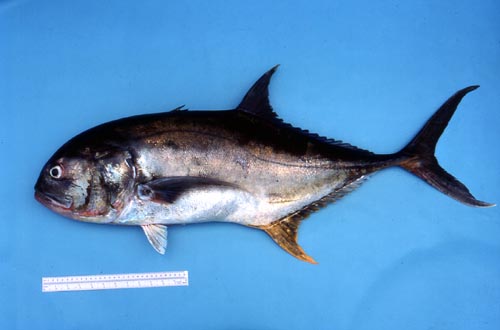
Although the crevalle jack is a relevantly unimportant commercial fish, it is fished commercially throughout the year in southwest Florida, and in the spring, fall, and summer in the Gulf of Mexico. It is an important sport fish, and is exploited throughout its range. It is the most common large jack caught off the west coast of Florida.
Danger to Humans
There have been some reports of ciguatera poisoning associated with this jack. Ciguatera poisoning occurs when humans eat a fish that has eaten a toxin that is produced by the dinoflagellate, Gambierdiscus toxicus, and it is digested by the fish. This poisoning, although it is usually self-limiting, can affect humans in many ways. It has gastrointestinal, neurological, and cardiovascular symptoms.
Conservation
> Check the status of the crevalle jack at the IUCN website.
The IUCN is a global union of states, governmental agencies, and non-governmental organizations in a partnership that assesses the conservation status of species.
Geographical Distribution
The crevalle jack’s range consists mainly of the coastal areas of the western Atlantic Ocean from Novia Scotia to Uruguay. They also often are found throughout the Gulf of Mexico, especially along the coast of Texas and the west coast of Florida.
Habitat
The crevalle jack is found in oceanic, estuarine or riverine environments. This is influenced by the life stage of the fish. They primarily are found along the continental shelf, but occur in waters as deep as 327 feet (100 m). Fish found in these deep waters are usually larger individuals. Larval and juvenile jack crevalles are found in upstream currents and are common in shallow brackish waters. Adults, on the other hand, usually occupy upstream currents, reefs, offshore areas or shallow inshore areas. Jack crevalles live in a variety of temperatures and salinities. Adults usually inhabit areas with temperatures between 64-92.5°F (18-33.6ºC) of water and larvae are found in areas with temperatures between 69-84.9°F (20.4-29.4ºC) of water. Crevalle jacks have been found in fresh water to salt water environments, depending on life stage. Larvae have been collected in areas with salinities between 35.2-36.7 parts per thousand (ppt). Adults have been found in freshwater habitats as well as those with a salinity of 43.8 ppt. They are most commonly found at salinity above 30 ppt. The crevalle jack is a pelagic fish. Both adults and juveniles are usually found in schools. However, larger individuals may be found swimming the waters alone.
Biology
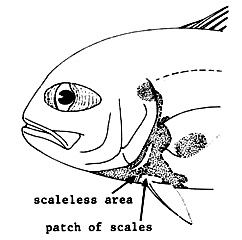
Distinctive Features
The crevalle jack has a body depth of about three times its fork length. It has large eyes. The chest is scaleless except for a small patch of scales in front of the pelvic fins. This patch is apparent by the time the fish reaches a fork length of 0.98 inches (2.5 cm). The crevalle jack is the only jack in the western Atlantic Ocean with this patch of scales. There is an oval black spot on the pectoral fins; this appears at about 4.72 inches (12.0 cm). Between the seventh and the eighth spines of the adult there is an overgrowth of skin. The two most distinguishable features of this fish are the patch of scales between the pelvic fins and the oval, black spot on the pectoral fins.
Coloration
The crevalle jack is greenish-bluish or bluish-black above and silvery white to yellowish or golden below. This serves to blend in with the water from a predator searching from above, and to blend with the sunlight from a predator hunting from below. There is an oval, black spot on the pectoral fins. Juveniles have 5 dark bars on their bodies. These black bars are present until the fish reaches a size of 6.46 inches (16.4 cm). There is an area of dark pigment above the peduncle that appears at 1.18 in. (3.0 cm) and is very dark once the fish reaches a size greater that 3.94 inches (10.0 cm) in length.
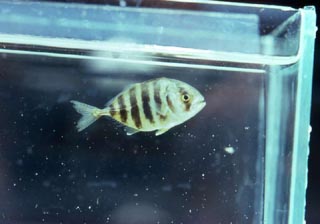
The juvenile has pigment spots on the anal spines and membranes, which disappear by the time its size reaches 1.38 inches (3.5 cm). The pelvic fin remains unpigmented after 0.79 inches (20 mm) and at about 1.18 inches (3.0 cm) the pigment of the caudal fins develops. The coloration of the juvenile holds between 0.79-1.57 inches (2.0-4.0 cm) and fades between 1.57-1.97 inches (4.0-5.0 cm).
Dentition
The crevalle jack has three paired patches of small villiform teeth located dorsally. These teeth are larger than the premaxillary teeth. Ventrally, the jack crevalle has a single pair of triangular patches of smaller teeth. These teeth, in combination with the air bladder, are responsible for the croaking noise it makes when it is caught. The fish rasp their upper and lower teeth together, this combined with air bladder resonance, are the factors contributing to the sound.
Size, Age, and Growth
The maximum size of a crevalle jack is 39.8 inches (101 cm) and 55.1 pounds (25 kg), however they are common to 23.6 inches (60 cm). After the juvenile reaches a size of 1.97 inches (5.0 cm), its growth rate increases. Females are typically larger than males.
Food Habits
The crevalle jack is a diurnal predator. Adults prey upon on a variety of fish, shrimp and invertebrates. Juveniles feed mainly on small fish and crustaceans.
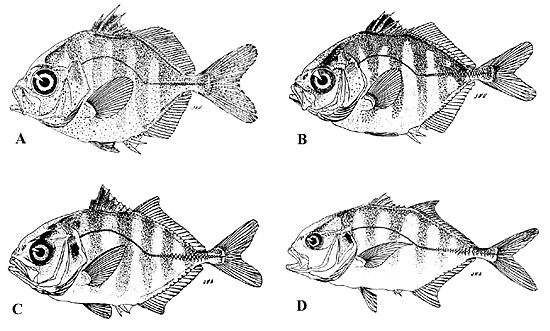
Reproduction
The spawning season of the crevalle jack is early March to early September. Spawning occurs offshore in the southeastern Atlantic coast and in the Gulf Stream, including any associated currents. The crevalle jack has been found to spawn in both tropical and subtropical environments. The eggs of the crevalle jack are between .03-.04 inches (0.7-0.9 mm) in diameter and the newly hatched larvae are between 0.06-0.07 inches (1.6-1.8 mm) in length. The larva use estuaries as nurseries. In juveniles the small patch scales on the chest form at 0.98 inches (25 mm). The pigmentation of the first dorsal fin decreases above 1.2 inches (30 mm), pigment appears on the second dorsal fin at 1.2 inches (30 mm), and the pelvic fin is unpigmented above 0.8 inches (20 mm). The pectoral spot develops at about 4.7 inches (120 mm).
Predators
The crevalle jack is prey for many surface feeding carnivores, such as finfish including the striped marlin (Tetrapturus audax), and sea birds.
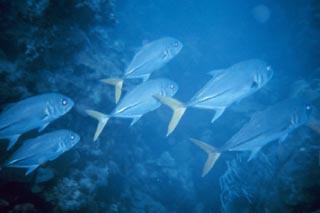
Parasites
Two known parasites of the crevalle jack are Stephanostomum ditrematis and Bucephalus varicus, both digenic trematodes. S. ditrematis inhabits the rectum of the host. It is common in fish taken off the coasts of Massachusetts and Florida. This parasite affects all carangids. Another known parasite, B. varicus, inhabits the pyloric junction or the entire length of the intestine. Copepods are also common parasites to the crevalle jack including Anuretes heckelii found on the wall of branchial cavities, Caligus chorinemi and Caligus coryphaenaeare both parasitic on the body surface as well as in the branchial cavities, and Lernaeenicus longiventris which is parasitic in the flesh of the fish. Other parasites include protozoans, monogenea (gillworms), cestoda (tapeworms), and nematoda (roundworms).
Taxonomy
Caranx hippos was first described by Linnaeus in 1766 as Scomber hippos. It was first referred to as Caranx hippos in 1766 and this name is still in use. Through the years, it has appeared under a variety of different names. Caranx is derived from the French word “carangue” which means a Caribbean fish while hippos is Greek for “horse”. Although these names are no longer valid, these included Scomber carangus Bloch 1793, Caranx carangus Bloch 1793, Caranx carangua Lacepede 1801, Caranx erythrurus Lacepede 1801, Caranx antilliarum Bennett 1840, Caranx defensor DeKay 1842, Trachurus cordyla Gronow 1854, Caranx esculentus Girard 1859, Caranx hippos caninus Gunther 1869, andCaranx hippos tropicus Nichols 1920.
Prepared by: Tina Perrotta